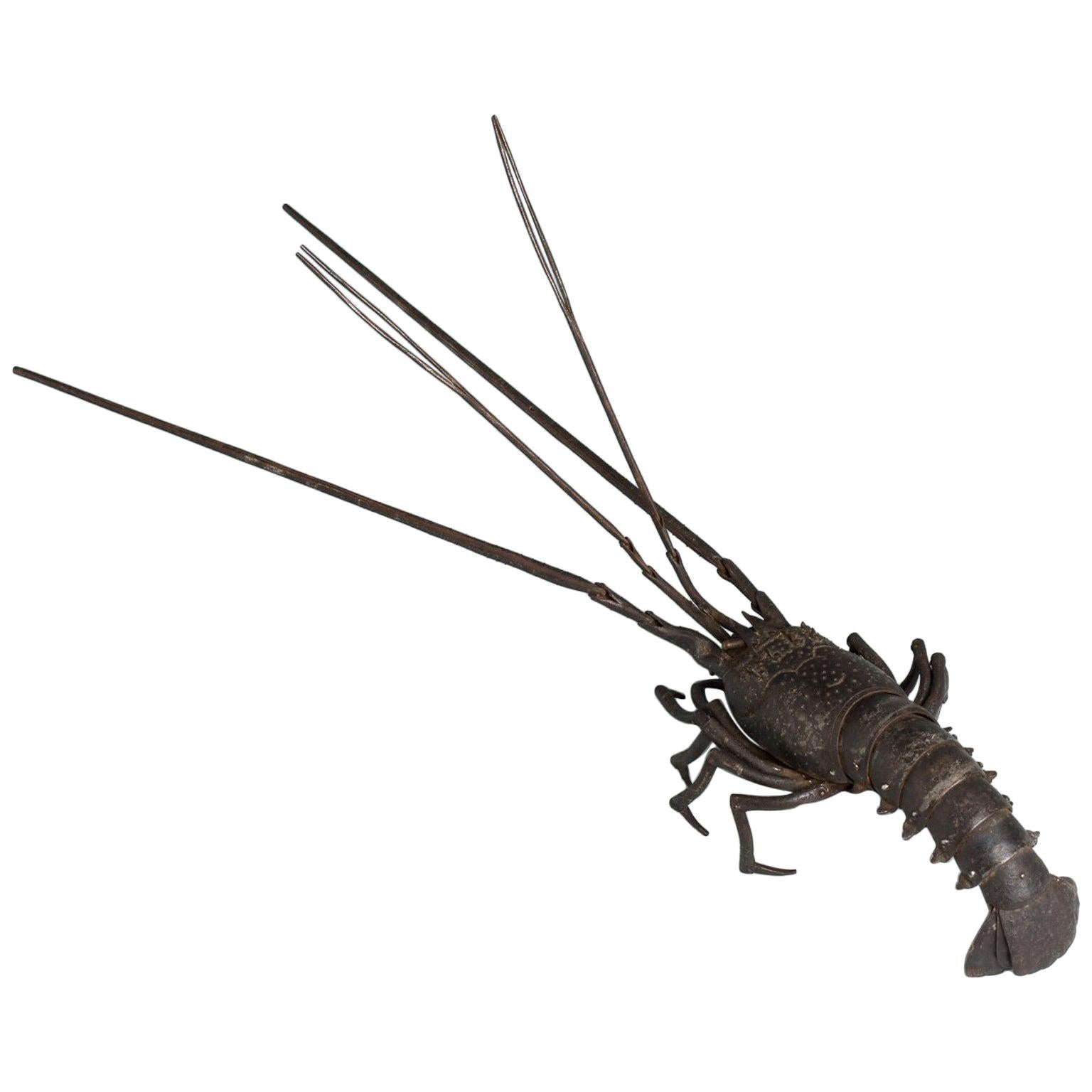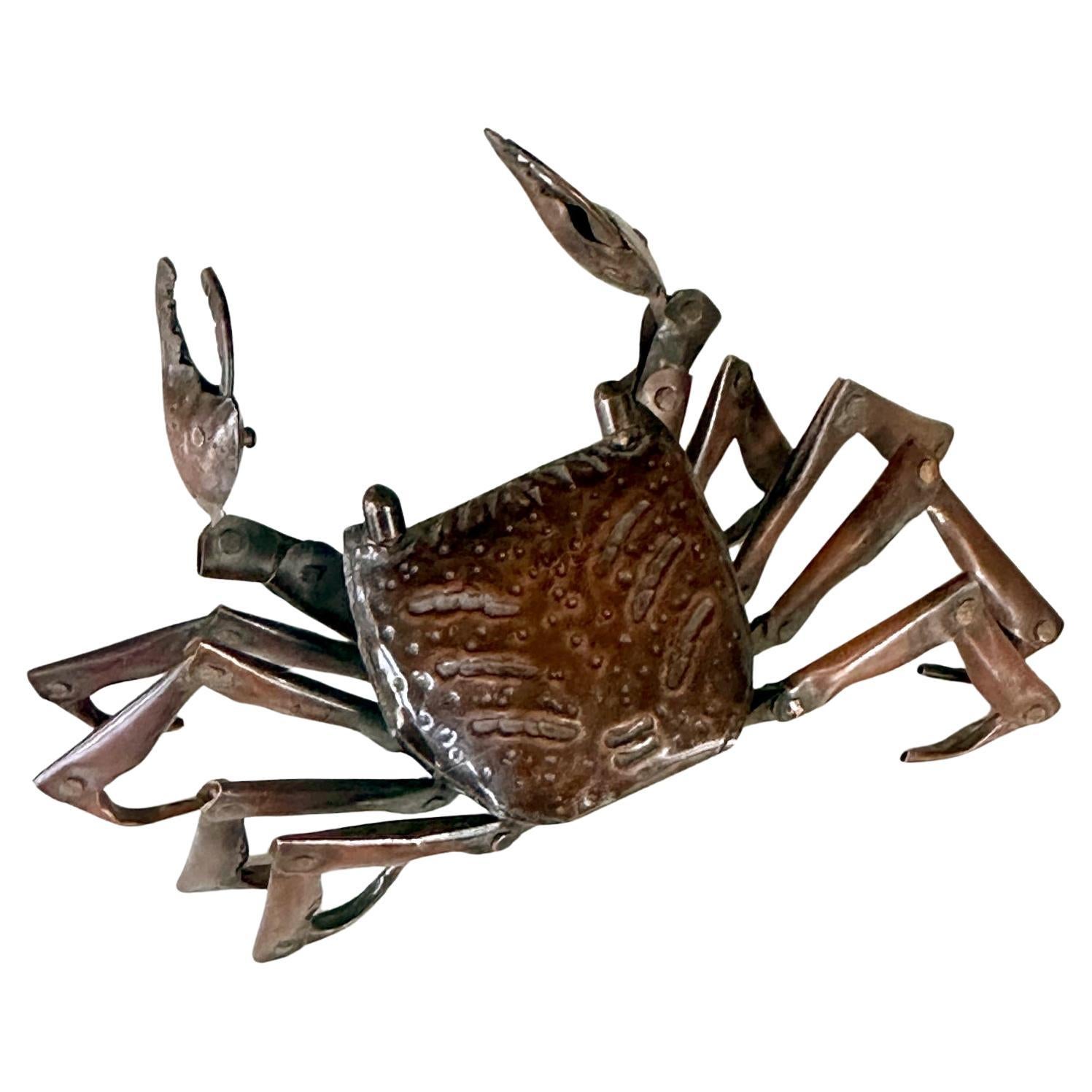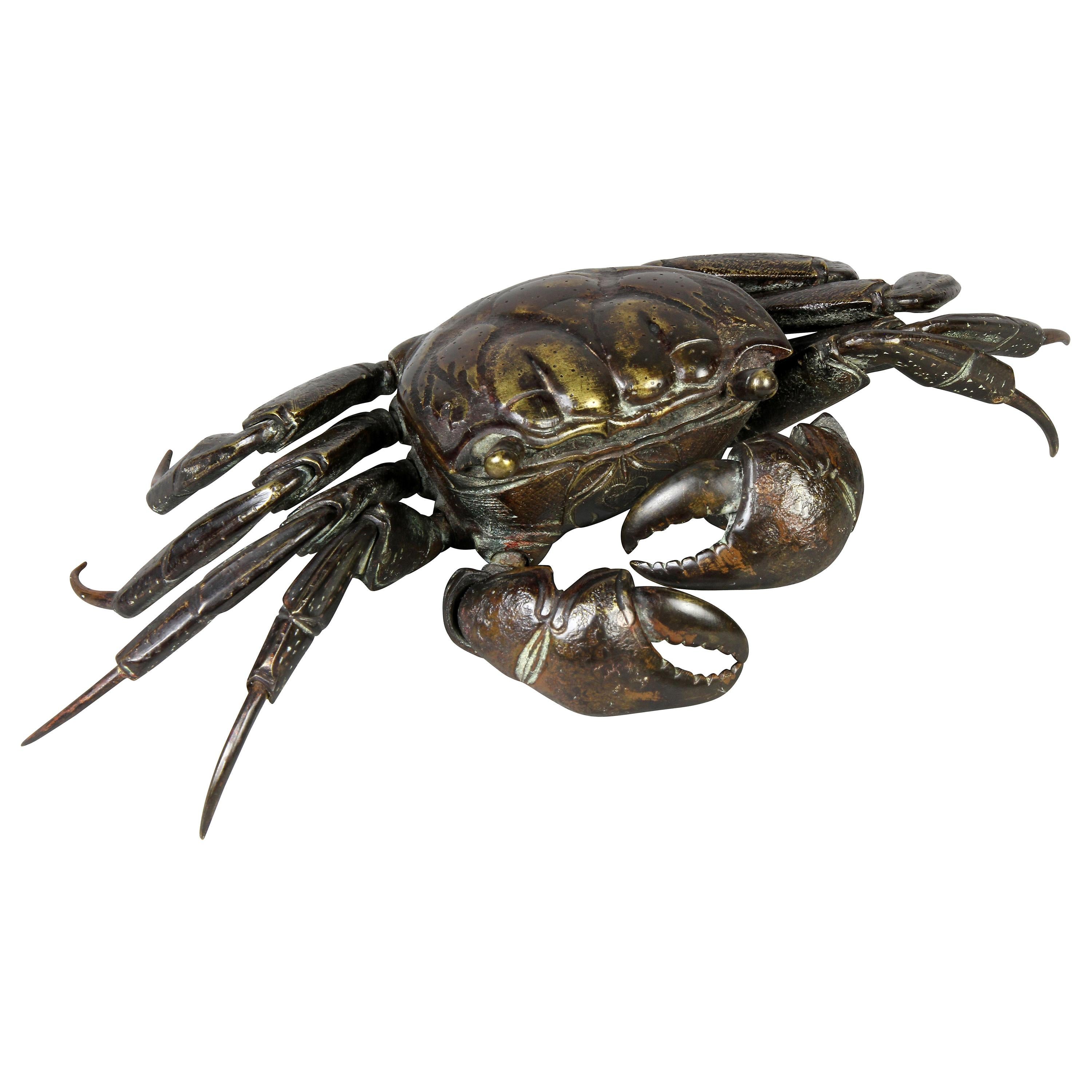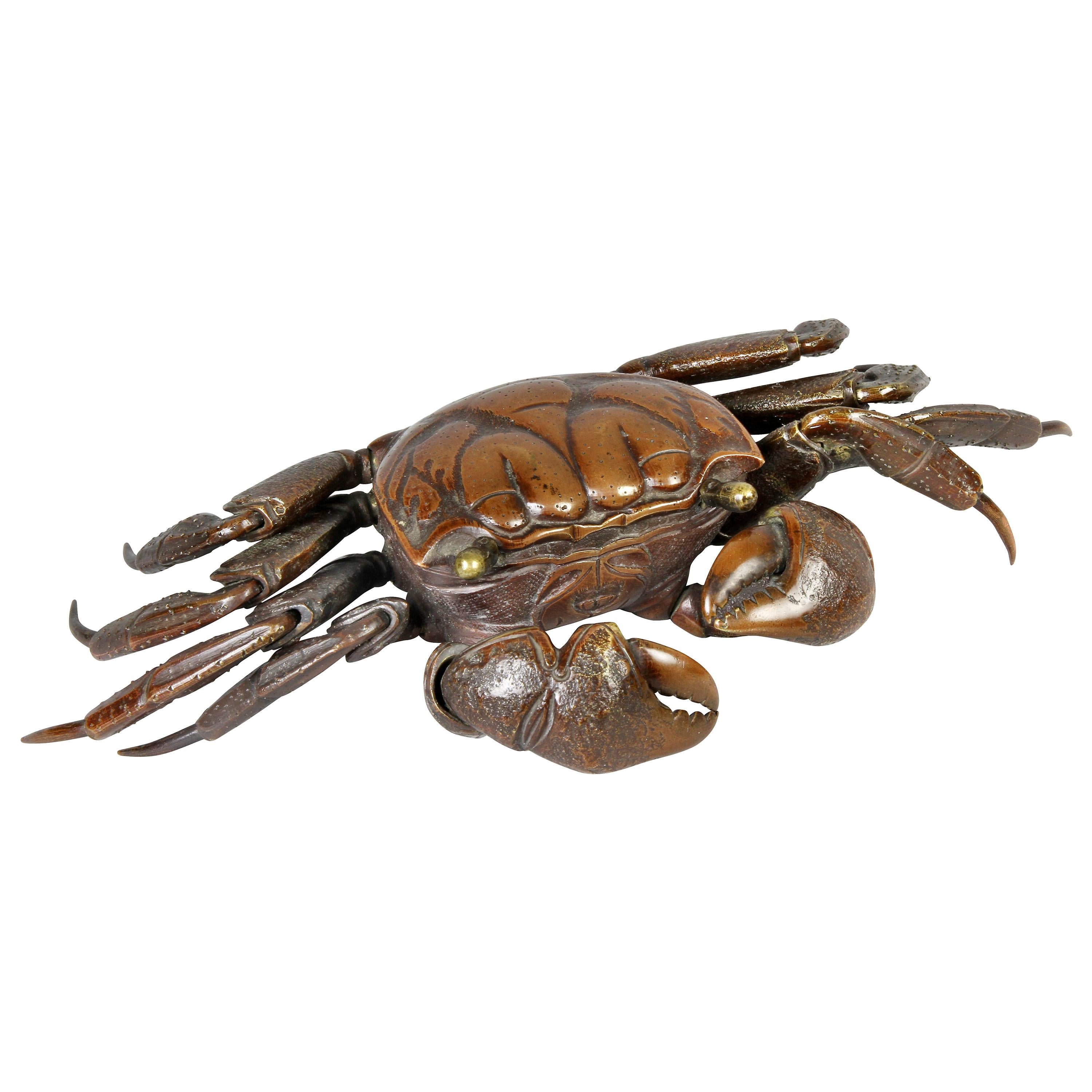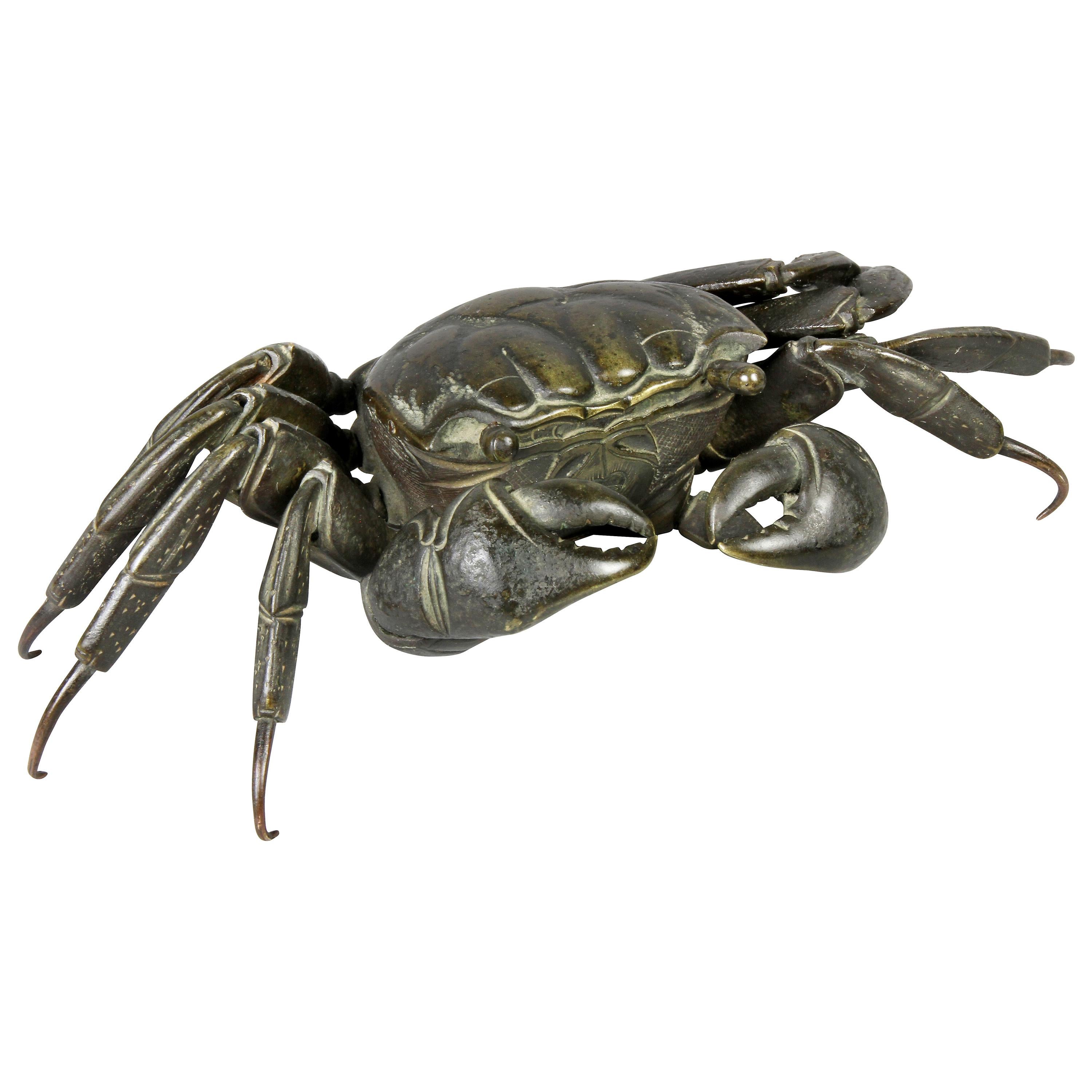Items Similar to Jizai Okimono, Russet-Iron Articulated Figure of a Crab
Want more images or videos?
Request additional images or videos from the seller
1 of 5
Jizai Okimono, Russet-Iron Articulated Figure of a Crab
About the Item
Jizai Okimono
A russet-iron articulated figure of a crab
Edo Period (1615 - 1867), 19th Century
Length: 15 cm with extended limbs
The iron crab is constructed of numerous hammered plates, jointed inside the body; the claws open and the limbs and eyes move.
Jizai Okimono are realistically shaped figures of animals made from iron, copper, shibuichi or shakudo. Their bodies and limbs are articulated, and can be moved like real animals; among these figures we can find models of dragons, birds, fishes, snakes, lobsters, crabs and insects.
There are only few dated pieces, the earliest known is a dragon bearing the signature of Myochin Muneaki and dated 1713; from the XVIII century there is also a dated butterfly by Myochin Muneyasu (1753). The Myochin were armor makers who excelled in iron forging and hammer work, and are thought to have produced these okimono (ornamental figures) in the peaceful time of the mid-Edo period. During this time of peace in Japan, the decrease in demand for armor and weapons allowed metal artisans to express their creativity in the production of these fascinating objects of nature. Jizai okimono began to be exported overseas in the Meiji period (1868-1912), together with those produced at that time, with the studio of Takase Kozan as their major producers. Kozan used bronze and shibuichi in addition to iron, working to make their works more realistic by using metals of different colors. Meiji pieces are generally lighter in weight as result of thinner metal plates used in their construction.
The term “jizai okimono” seems to be quite modern: In the 1893 Chicago World's Columbian Exposition the craftsman Itao Shinjiro (Kiyoharu, b. 1842) showed an articulated piece which was described as kusshin jizai tsubasa no okimono (an okimono with wings that move in and out freely) and the word jizai is seen again in this context on the storage box for an articulated dragon purchased by Tokyo National Museum in 1911. The only known Edo-period box inscription referring to one (a small dragon) calls it a bunchin (paperweight).
- Dimensions:Height: 1.19 in (3 cm)Width: 1.97 in (5 cm)Depth: 5.91 in (15 cm)
- Materials and Techniques:
- Place of Origin:
- Period:
- Date of Manufacture:circa 1850
- Condition:
- Seller Location:Milano, IT
- Reference Number:1stDibs: LU4250227215282
About the Seller
5.0
Recognized Seller
These prestigious sellers are industry leaders and represent the highest echelon for item quality and design.
Established in 2005
1stDibs seller since 2018
10 sales on 1stDibs
Typical response time: 2 hours
- ShippingRetrieving quote...Ships From: Milano, Italy
- Return PolicyA return for this item may be initiated within 7 days of delivery.
More From This SellerView All
- Japanese Articulated Iron Jizai Okimono of a Lobster by Myochin MuneharuLocated in Milano, ITThis articulated okimono represents a naturalistically rendered lobster, with fully articulated limbs, antennae, body, and tail and comes with an inscribed wood storage box. Signed:...Category
Antique 19th Century Japanese Metalwork
MaterialsIron
- Tōkanmuri Kabuto Samurai Helmet in the Shape of a Court CAPLocated in Milano, ITTokanmuri kabuto Samurai helmet in the shape of a court cap Momoyama to early Edo Period 17th century The wearing of helmets that reproduced the shapes of traditional ...Category
Antique 17th Century Japanese Metalwork
MaterialsIron
- Go-Mai Uchidashi Dō Tosei Gusoku Samurai Armor Decorated with an Embossed RabbitLocated in Milano, ITGo-mai uchidashi do tosei gusoku Samurai armor decorated with an embossed rabbit Edo period, 19th century This samurai armor is complete and original, with consistent elements...Category
Antique 19th Century Japanese Metalwork
MaterialsIron
- Suji-bachi kabuto and menpo Signed by Myōchin Muneaki and dated 1853Located in Milano, ITSuji-bachi kabuto and menpo Signed by Myōchin Muneaki and dated 1853 Signature: Kaei 6 - Ushidoshi Oshu Nihonmatsu-ju Myōchin Ki (no) Muneaki saku Made in 1853 by Myōchin Ki Muneak...Category
Antique 18th Century and Earlier Metalwork
MaterialsIron
- Sogonari Kabuto Samurai Helmet Shaped as a Human Head Early Edo PeriodLocated in Milano, ITSogonari Kabuto Samurai Helmet shaped as a Human Head Early Edo Period (1615 - 1867). Three-plates kawari kabuto covered with tawny hair to ...Category
Antique Early 1700s Metalwork
MaterialsFur
- Okitenugui Kabuto Samurai Helmet Shaped as a Head Towel Saika, Early Edo PeriodLocated in Milano, ITOkitenugui kabuto Samurai helmet shaped as a head towel Saika, early Edo period, 17th century The Haruta armorers who moved to Kii province in the early 17th century, took the name from the village where they worked, Saika, near Wakayama, possibly on request of the local daimyo, Asano Yukinaga, a great armour amateur. Specialised in the construction of plate helmets, they produced mainly two typologies of kabuto: one with six plates covered with a chrysanthemum-shaped plate on top and one shaped as a “head towel”, called okitenugui. The latter type of kabuto employs very heavy plates crafted in a curved manner and was improved in order to make it resistant to firearms. This okitenugui kabuto features some distinctive decorations of the Haruta school, including the application of cut-out iron elements, including eyebrows, washers and lozenge-shaped decorations on the sides. The ring on the top, however, is a rare feature and could be used to hold a small war flag.Category
Antique 17th Century Metalwork
MaterialsIron
You May Also Like
- Small Japanese Articulate Crab Jizai Okimono Meiji Period SignedBy Myochin HiroyoshiLocated in Atlanta, GAA small copper crab with articulated legs made by Myochin Hiroyoshi in the late Meiji Period circa 1890-1900s. As an ornamental display item, this type of small sculpture with moving...Category
Early 20th Century Japanese Japonisme Metalwork
MaterialsCopper
- Japanese Meiji Articulated Bronze CrabLocated in Essex, MADarker brown patina with fully articulated body. Purchased in London by previous owner.Category
Antique 1870s Japanese Meiji Animal Sculptures
MaterialsBronze
- Japanese Meiji Articulated Bronze CrabLocated in Essex, MAWonderful patina and fully articulated. Purchased in London by previous owner.Category
Antique 1870s Japanese Meiji Animal Sculptures
MaterialsBronze
- Japanese Meiji Articulated Bronze CrabLocated in Essex, MADark greenish brown patina with fully articulated body. Purchased in London by past owner.Category
Antique Late 19th Century Japanese Meiji Animal Sculptures
MaterialsBronze
- Japanese Meiji Articulated Bronze CrabLocated in Essex, MADark copper toned patina, wonderfully articulated. Purchased in London by previous owner.Category
Antique 1870s Japanese Meiji Animal Sculptures
MaterialsBronze
- Japanese bronze okimono Jizai Praying Mantis (articulated sculpture)Located in PARIS, FRJizai okimono sculpture of an articulated bronze praying mantis. Insects (mushi) play an important role in Japanese culture. Insect hunting is a popular pastime, especially among chi...Category
Antique Mid-19th Century Japanese Japonisme Sculptures and Carvings
MaterialsBronze
